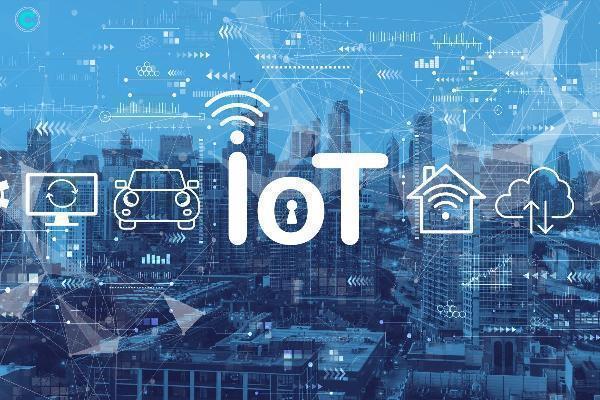Top 16 IoT Devices that Connect the World

Strong 8k brings an ultra-HD IPTV experience to your living room and your pocket.
Top 16 IoT Devices that Connect the World | CyberPro Magazine
In an increasingly interconnected world, the Internet of Things (IoT) has emerged as a transformative force, revolutionizing the way we interact with technology. But what exactly is IoT? At its core, IoT refers to the network of physical objects—devices, vehicles, appliances, and more—embedded with sensors, software, and other technologies to connect and exchange data with other devices and systems over the internet. These IoT devices are pivotal in enhancing convenience, efficiency, and connectivity in our daily lives. Let’s explore the top 16 IoT devices that are reshaping our world.
Here are the top 16 IoT devices:
1. Smart Thermostats
Smart thermostats, like the Nest Thermostat, are revolutionizing home climate control. These devices learn your schedule and preferences, adjusting the temperature automatically to ensure optimal comfort. By using algorithms to understand your habits, they can preemptively heat or cool your home, creating a perfect environment by the time you walk in the door. Moreover, smart thermostats contribute to energy savings by reducing unnecessary heating or cooling, which can significantly lower utility bills. With features like remote access through smartphone apps, you can adjust your home’s temperature from anywhere, ensuring comfort and efficiency at all times.
2. Smart Lighting Systems
Top 16 IoT Devices that Connect the World | CyberPro Magazine
Smart lighting systems, such as Philips Hue, offer unparalleled control over your home’s lighting. These systems allow you to adjust brightness, change colors, and set schedules through a smartphone app or voice commands. Imagine setting the perfect ambiance for a dinner party with a single tap, or waking up to gradually increasing light that simulates a sunrise. Smart lighting systems can also be integrated with other smart home devices, creating a cohesive and automated home environment. Additionally, they contribute to energy efficiency by allowing you to control lights remotely and set schedules to ensure lights are only on when needed.
3. Smartwatches
Smartwatches, like the Apple Watch and Samsung Galaxy Watch, have become essential gadgets for modern living. These devices do much more than tell time; they track your fitness, monitor your heart rate, and keep you connected with notifications for messages and calls. Equipped with GPS, smartwatches can assist with navigation, making them invaluable for outdoor activities. Various health apps can track everything from sleep patterns to calorie intake, providing a comprehensive view of your well-being. With the ability to install apps, smartwatches can cater to a wide range of needs, making them versatile tools for both personal and professional use.
Apple Watch Ultra vs Samsung Watch (Don’t Be Disappointed)
4. Fitness Trackers
Fitness trackers, such as Fitbit and Garmin, have revolutionized personal health monitoring. These devices track steps, monitor sleep patterns, measure heart rate, and even analyze workouts. By providing real-time data and insights, fitness trackers help users set and achieve health goals. Many models offer additional features like GPS tracking for outdoor activities, guided breathing exercises, and stress monitoring. With their ability to sync with smartphone apps, fitness trackers offer a detailed and holistic view of your health, empowering you to make informed decisions about your lifestyle and fitness routines.
5. Remote Patient Monitoring
Healthcare is being transformed by IoT devices that enable remote patient monitoring. Devices like continuous glucose monitors (CGMs) and remote cardiac monitors allow doctors to keep tabs on patients’ conditions in real-time, reducing the need for frequent hospital visits. For chronic disease management, these devices provide invaluable data, enabling timely interventions and personalized treatment plans. Patients can enjoy greater peace of mind knowing their health is being monitored continuously, while healthcare providers can make more informed decisions based on accurate, up-to-date information.
6. Smart Medical Devices
Smart medical devices, such as connected inhalers and smart pills, are enhancing patient care and treatment adherence. Connected inhalers track medication usage and send reminders to patients to ensure they take their medications correctly. Smart pills, embedded with tiny sensors, transmit data to a wearable patch, which then sends the information to a smartphone app, confirming that medication has been ingested. These innovations help healthcare providers monitor treatment effectiveness and adjust therapies as needed. By ensuring patients adhere to their prescribed regimens, smart medical devices improve health outcomes and reduce the risk of complications.
7. Vehicle Telematics
Connected cars use vehicle telematics to gather and transmit data about driving behavior, vehicle health, and location. This information can be used to improve safety, optimize routes, and reduce insurance premiums. For fleet management, telematics provide valuable insights into vehicle usage, fuel consumption, and maintenance needs, enabling more efficient operations. By monitoring driving habits, such as speed, braking, and acceleration, telematics can also promote safer driving practices. Additionally, real-time location tracking enhances navigation and helps in recovering stolen vehicles.
8. Autonomous Vehicles
Autonomous vehicles, powered by IoT and AI, are set to revolutionize transportation. These self-driving cars use a network of sensors, cameras, and advanced algorithms to navigate roads, offering a future where human drivers may become optional. By processing vast amounts of data in real-time, autonomous vehicles can make split-second decisions, improving safety and efficiency. They have the potential to reduce traffic accidents, ease congestion, and provide mobility solutions for those unable to drive. As the technology matures, autonomous vehicles will transform the way we travel, making transportation more accessible and sustainable.
9. Smart Sensors
Top 16 IoT Devices that Connect the World | CyberPro Magazine
In industrial settings, smart sensors are critical for monitoring equipment performance and environmental conditions. These sensors can detect changes in temperature, pressure, humidity, and other variables, providing real-time data that can be used to optimize processes. By identifying anomalies early, smart sensors help prevent costly equipment failures and ensure safety. They also contribute to energy efficiency by monitoring and adjusting systems to operate at optimal levels. In manufacturing, smart sensors enable predictive maintenance, quality control, and enhanced operational efficiency.
10. Predictive Maintenance Tools
Predictive maintenance tools leverage IoT data to predict when equipment is likely to fail, allowing for timely maintenance before issues become critical. By analyzing data from sensors, these tools can identify patterns and trends that indicate potential problems. This proactive approach reduces downtime, extends the lifespan of equipment, and lowers maintenance costs. Industries such as manufacturing, oil and gas, and transportation benefit greatly from predictive maintenance, as it ensures continuous operations and minimizes the risk of unexpected failures.
11. Intelligent Traffic Management
IoT is crucial for building smart cities, and intelligent traffic management systems are a prime example. These systems monitor traffic flow, adjust signals in real-time, and provide data to optimize transportation networks. By reducing congestion and improving road safety, intelligent traffic management systems enhance urban mobility. They can also integrate with public transportation systems, providing real-time updates on schedules and delays. Smart traffic lights and sensors help reduce emissions by minimizing idle times, contributing to a cleaner and more efficient urban environment.
12. Smart Waste Management
Smart waste management systems use IoT sensors to monitor waste levels in bins and schedule pickups efficiently. This approach reduces waste collection costs, optimizes routes for garbage trucks, and minimizes environmental impact. Sensors can detect when bins are full and send alerts to waste management services, ensuring timely and efficient collection. By analyzing data on waste patterns, cities can implement better recycling programs and reduce landfill usage. Smart waste management contributes to cleaner, more sustainable urban living.
13. Precision Farming Tools
Top 16 IoT Devices that Connect the World | CyberPro Magazine
Precision farming tools, such as soil sensors and weather stations, help farmers optimize their use of resources. These devices provide real-time data on soil health, moisture levels, and weather conditions, enabling more efficient and sustainable farming practices. By analyzing this data, farmers can make informed decisions about irrigation, fertilization, and crop management. Precision farming tools help increase crop yields, reduce water usage, and minimize environmental impact. They are essential for modern agriculture, ensuring food security and promoting sustainable farming.
14. Livestock Monitoring Systems
Livestock monitoring systems track the health and behavior of animals using IoT technology. These systems can monitor vital signs, detect illnesses, and track movement, providing farmers with valuable insights into their herds’ well-being. By receiving alerts about issues such as illness or abnormal activity, farmers can intervene promptly, ensuring timely treatment and better animal welfare. Livestock monitoring systems also help optimize breeding programs and manage grazing patterns, contributing to more efficient and sustainable livestock farming.
15. Smart Shelves
Smart shelves in retail stores use sensors to monitor inventory levels and provide data on product popularity and customer preferences. These shelves can automatically trigger restocking orders when inventory is low, ensuring products are always available for customers. By analyzing sales data, smart shelves help retailers optimize product placement and pricing strategies. They also enhance the shopping experience by providing real-time information about product availability and location within the store.
16. Automated Checkout Systems
Automated checkout systems, like Amazon Go, use IoT technology to streamline the shopping experience. Customers can simply pick up items and leave the store, with payments processed automatically through their mobile devices. These systems use a combination of sensors, cameras, and machine learning algorithms to track items and calculate the total cost. Automated checkout systems reduce wait times, improve convenience, and enhance the overall shopping experience. They also provide retailers with valuable data on shopping patterns and customer preferences.
FAQs
1. What are IoT devices?
IoT devices are physical objects embedded with sensors, software, and other technologies to connect and exchange data with other devices and systems over the internet.
2. How do IoT devices work?
IoT devices collect data from their environment through sensors and send this data over the internet to other devices or systems for processing and analysis.
3. What are the benefits of using IoT devices?
The benefits of using IoT devices include increased efficiency, convenience, improved decision-making, cost savings, and enhanced safety and security.
4. Are IoT devices secure?
While IoT devices offer many benefits, they also pose security risks. It’s important to use secure devices, keep software updated, and follow best practices for data protection.
5. What is the future of IoT?
The future of IoT is expected to see even greater integration and innovation, with advancements in AI, 5G, and other technologies driving new applications and enhancing existing ones.
Conclusion
The future of IoT is incredibly promising, with endless possibilities for innovation and integration across various industries. As technology continues to advance, IoT devices will become even more integral to our daily lives, enhancing connectivity, efficiency, and convenience. From smart homes to smart cities, the impact of IoT is undeniable, and its potential to transform the world is immense. By embracing IoT technologies, businesses and consumers alike can benefit from improved productivity, sustainability, and quality of life.
Also Read: Navigating the Future of IoT Data Security: Trends, Challenges, and Solutions
Note: IndiBlogHub features both user-submitted and editorial content. We do not verify third-party contributions. Read our Disclaimer and Privacy Policyfor details.


